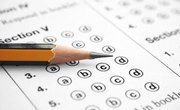Speech intelligibility is the accuracy with which a normal person comprehends a spoken word or phrase. In today's technological world, communication happens in many forms, but verbal communication is undeniably the most clear. Most speech communication is shaded with context through gestures and other visual cues. However in large groups, listeners are forced to rely on the sound of the word rather than visual clues. Measuring speech intelligibility allows businesses, educators and communicators to measure their effectiveness.
Step 1
Prepare a list of monosyllabic words that are phonetically balanced, meaning all possible linguistic sounds are used equally. Another option is to create a list of syllables that do not create words. These should be meaningless and jumbled. The latter option eliminates the influence of non-phonetic cues when measure the intelligibility of speech.
There are a variety of testing methods. Above is an example of how to create a Phonetically Balanced Word List. The primary modification on each testing method is the type of list prepared. These include the Diagnostic Rhyme Test, Diagnostic Medial Consonant Test, Diagnostic Alliteration Test, Modified Rhyme Test and Spelling Alphabet Test.
Step 2
Gather a test group in an enclosed space. Give each individual a test sheet on which they will record the sounds they hear. For easier testing, break the sounds down into number sections. On the test sheet, include each number and enough space for them to record the allotted words or syllables. Before beginning a new section, signal to your test group which section of the sheet they should be filling out.
Step 3
Using pre-recorded text or a live reading, communicate the prepared list of words or syllables. Some testers may cue their test group to listen for a particular syllable or word within a sentence. This method simulates more realistic fluent speech. Ask the testers to record what they hear.
Step 4
Grade each test on a percentage scale. The number of correct answers divided by the total number of answers gives a percentage of speech intelligibility. Average the set of scores to define the overall speech intelligibility of the person giving the test.
Step 5
Repeat the testing scenario for more accurate results. The more subjects tested, the more likely the speech intelligibility average is accurate.
Related Articles
References
Writer Bio
Katelyn Coyne has been a freelance writer based out of Indianapolis since 2009. Her areas of expertise include theater, arts, music, dance, literature and popular culture. She has published work for the Indianapolis-based website FunCityFinder.com and other online publications. She holds a Bachelor of Arts in theater with a minor in English from Butler University.










